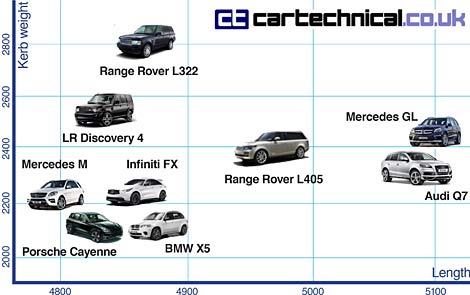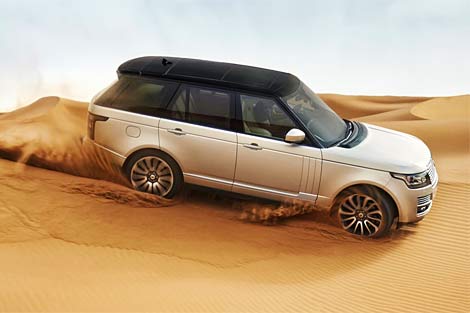
One of the key details about the new Range Rover released yesterday was that the L405’s all-alloy monocoque structure will lop up to 420kg off the kerb weight, compared to the outgoing L322 model – a reduction of 15%. Land Rover says the reduction in weight will improve performance, economy, emissions and handling – and no doubt it will. Results from a 2008 study by Ricardo (available as a PDF) suggest that a reduction in the weight of a large SUV of this kind can give a fuel economy improvement of around 3.5%, at the same time lopping about a second from the vehicle’s 0-60mph time. If the engine is downsized to retain the same performance as before, the fuel economy benefit could be as much as 13%.
But it’s interesting to note that even with its fancy all-aluminium body, L405 will be no lightweight. The current Range Rover weighs in at a not inconsiderable 2810kg. Carve a 420kg lump off that and you are left with 2390kg, which still makes the L405 heavier than many of its rivals – as the chart above shows.
We’ve compared the new Range Rover’s weight to key rivals, and to the existing Range Rover and Discovery 4. Kerb weight is plotted against length. Assuming that a bigger vehicle should weigh more, we should see a progression from shorter, lighter vehicles in the bottom left of the graph to longer, heavier machines in the top right. Anything in the top left of the chart is heavy for its size (or short for its weight, if you prefer). A vehicle in the lower right corner would be large but light.
The first conclusion from the chart is that the outgoing Range Rover really is very heavy indeed, way out on its own at the top of the chart and weighing the best part of 600kg more than rivals like the BMW X5 and Mercedes M-class. At the other end of the scale the lightest versions of Porsche’s Cayenne weigh just under two tonnes, a whopping 815kg less than the Range Rover. The difference is more than whole a Citroen C1 (800kg).
It’s also easy to see from the chart how the new Range Rover’s aluminium construction makes it much lighter than either the outgoing model or the Discovery, even though it is bigger than both. In fact, the new Range Rover inhabits a curious no-man’s land between a cluster of SUVs which are merely big – like the M-class, X5, Cayenne, Discovery and Infiniti FX – and those which are truly mammoth, like the five-metre-plus Audi Q7 and Mercedes GL-class. That might mean Land Rover couldn’t stomach the idea of making the Range Rover even bigger (appealing to US buyers at the expense of sales in the UK and Europe) or it might mean the JLR product planners have deliberately left to space for a long-wheelbase Range Rover in the future.
It’s also interesting to see where the Discovery would end up if it, too, was given an all-alloy monocoque. Assuming it slimmed down by a little less than has been achieved on the Range Rover, it would end up with a kerb weight of around 2250kg – right in the middle of that cluster of key rivals from Mercedes, BMW and others. Fuel economy and performance – both of which currently lag behind those rivals – would become far more competitive.

So the adoption of an alloy structure and the weight savings it brings give Jaguar Land Rover considerable potential for the future of its larger models. What isn’t yet clear is whether there are drawbacks, and we won’t know the answer to that until we drive the new Range Rover, and real users start to put them to the test in the real world.
Land Rover's products have always been based on their extraordinary ability to perform in all situations and on all terrain. There's little doubt that the new Range Rover will be an impressive vehicle and a capable off-roader, but whether it will have the reserves of strength inherent in the design of previous Range Rovers remains to be seen. Indeed whether that kind of capability is even necessary, in market sector the Range Rover now addresses, is open to question.
What is clear is that, regardless of the relatively conservative exterior, the engineering which underpins the new Range Rover is the boldest we have seen from Land Rover in decades.
